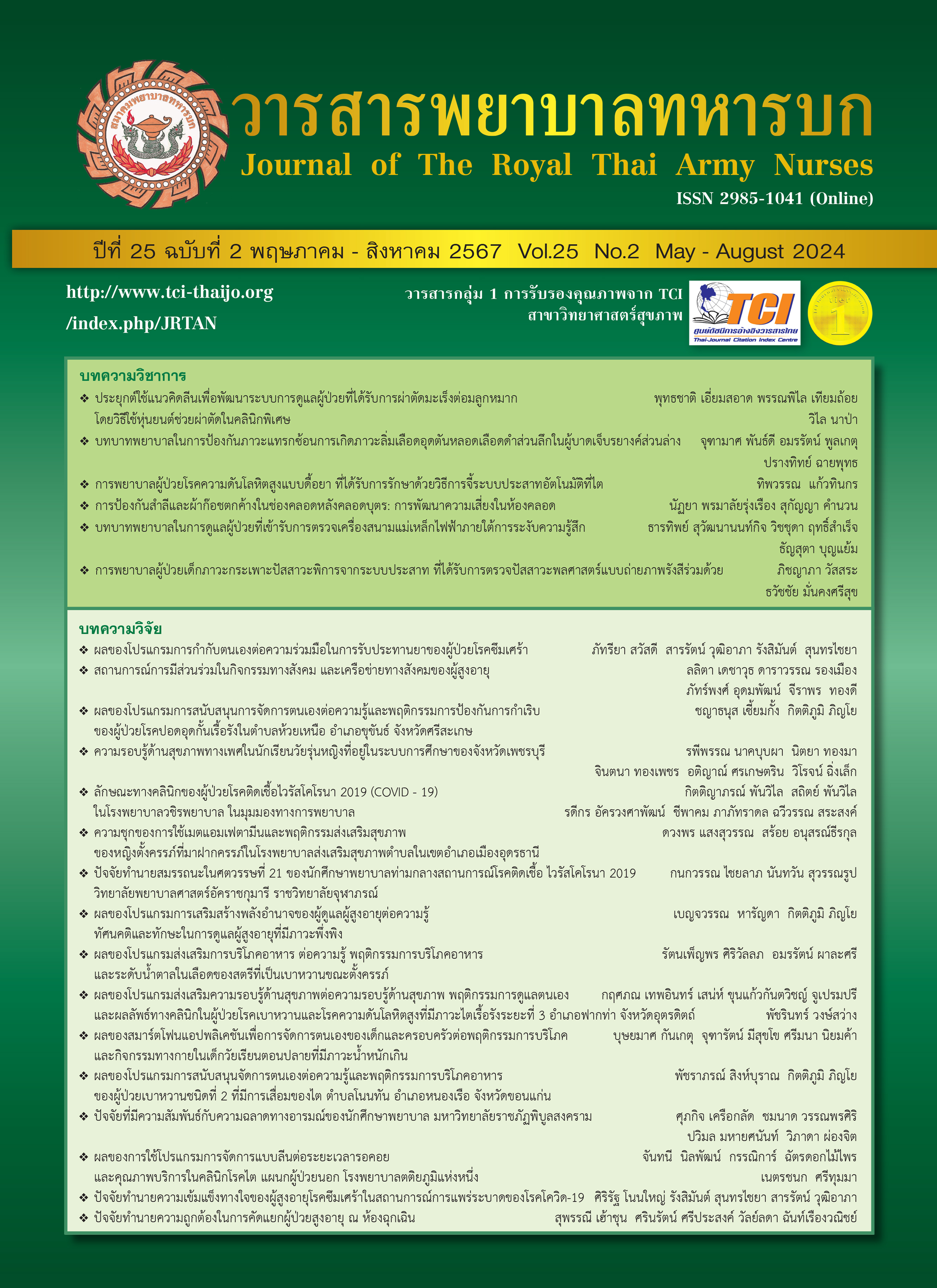Developing Seamless End-Stage Cancer Patient Care Models in the Community
Keywords:
Care for end-stage cancer patients, Seamless care in the community, CaregiverAbstract
Research and development were designed to develop a seamless community-based end-of-life cancer patient care model. We conducted the study between May 2022 and November 2023, which involved four phases: planning, implementation, observation, and reflection. The purposive sampling group consisted of 165 individuals, including medical personnel, local administrators, public health volunteers, patients, and caregivers. We utilized various research tools, including symptom assessment forms, quality-of-life assessments, and satisfaction surveys. We performed data analysis using descriptive statistics and paired sample t-tests.
The study identified several challenges in end-of-life cancer patient care, including inadequate patient problem assessment, insufficient personnel knowledge and skills, and shortcomings in utilizing communication technology and network coordination for support. The developed model encompassed comprehensive care systems, competency enhancement and personnel empowerment, and support systems linking networks at all levels. The model’s implementation led to significant improvements in patient symptoms, enforced care outcomes, patient and caregiver quality of life, and stakeholder satisfaction.
Downloads
References
Ferlay J, Colombet M, Soerjomataram I, Parkin DM, Piñeros M, Znaor A, Bray F. Cancer statistics for the year 2020: An overview. The International Journal of Cance. 2021; 149(4):778-89.
Strategy and Planning Division, Ministry of Public Health. Government action plan Ministry of Public Health 2022. (in Thai)
National Cancer Prevention and Control Plan Committee, Ministry of Public Health. National Cancer Control Programme (2018 – 2022). 2018 (in Thai)
Whitehead P, Keating S, Gamaluddin S, White C, Stewart C, Kim KY. Understanding the impact of community-based palliative care. In: Silbermann M, editor. Palliative Care for Chronic Cancer Patients in the Community. Cham: Springer; 2021.
Etkind SN, Bone AE, Gomes B, Lovell N, Evans CJ, Higginson IJ, Murtagh FE. How many people will need palliative care in 2040? Past trends, future projections and implications for services. BMC Medicine. 2017;15(102): 1-10.
Sapwongcharoen N., & Chintapanyakun T. Role of palliative care nurses in tertiary hospitals. The Journal of The Royal Thai Army Nurses. 2020; 21(1): 26-34 (in Thai)
Abu-Odah H, Molassiotis A, Liu J. Challenges on the provision of palliative care for patients with cancer in low- and middle-income countries: a systematic review of reviews. BMC Palliative Care. 2020;19(55): 1-16.
Nursing Division Ministry of Public Health. Nursing patients at home (home ward), Nonthaburi: Printing House of the Agricultural Cooperatives Association of Thailand; 2013. (in Thai)
National Health Commission Office (NHCO). Operational definition of terms related to palliative care for Thailand, 2020. (in Thai)
Nursing Division Ministry of Public Health. Guidelines for developing nursing service systems: Service Plan. Pathumtani: Publisher : Suea Tawan Co., Ltd.; 2018. (in Thai)
Kitsanayotin B, Pannarunothi S. Seamless primary care and the inconvenient truth about health data standards. Journal Health Systems Research. 2021;15(2):131-5. (in Thai)
Gillies, D. A. Nursing management: A system approach. (3rd ed). W.B. Saunders. 1994.
Palliative Care Committee, Nursing Department., Maharaj Nakorn Chiang Mai Hospital Palliative Performance Scale for Adult Suandok (PPS - Adult Suandok): 1988. (in Thai)
Sapinan L. Guide to using the palliative care outcomes assessment scale Thai version (palliative care outcome scale : POS). Chiangmai: Klang Wiang Printing Company Limited; 2013. (in Thai)
Cella DF, Tulsky DS, Gray G, Sarafian B, Linn E, Bonomi A, et al. The Functional Assessment of Cancer Therapy scale: development and validation of the general measure. Journal of Clinical Oncology. 1993;11(3):570-9.
Mahatnirunkul S., et al. Comparison of the WHOQOL-100 and the WHOQOL-BREF (26 items). Suan Prung Hospital - Psychiatric Hospital; 1998. (in Thai)
Apichatammarit N. The use of smartphones among health in Nong Bua Rawe district, Chaiyaphum Province. Chaiyaphum Medical Journal. 2022; 42(2): 82-93. (in Thai)
Nursing Division, Ministry of Public Health. Guidelines for storing indicators: Improving the quality of nursing services. Pathumtani: Suea Tawan Co., Ltd.; 2020. (in Thai)
Uttiya P. The role of nurses in home nursing services In caring for elderly patients with end-stage cancer. The Journal of The Royal Thai Army Nurses. 2020; 21(1): 18-25. (in Thai)
Chanpanit P., Wongmanee W., and Judabood N. Strengthening the community: role of village health volunteers. The Journal of The Royal Thai Army Nurse. 2023.; 24(3): 23-30. (in Thai)
Jirakangwan M. and Chantree S. The development of palliative care in end of life cancer patients: An integration of caring seamless network at Sisaket Hospital. Nursing Public Health and Education Journal. 2018;19(2): 70-83. (in Thai)
Downloads
Published
How to Cite
Issue
Section
License
Copyright (c) 2024 Journal of The Royal Thai Army Nurses

This work is licensed under a Creative Commons Attribution-NonCommercial-NoDerivatives 4.0 International License.
บทความหรือข้อคิดเห็นใดใดที่ปรากฏในวารสารพยาบาลทหารบกเป็นวรรณกรรมของผู้เขียน ซึ่งบรรณาธิการหรือสมาคมพยาบาลทหารบก ไม่จำเป็นต้องเห็นด้วย
บทความที่ได้รับการตีพิมพ์เป็นลิขสิทธิ์ของวารสารพยาบาลทหารบก
The ideas and opinions expressed in the Journal of The Royal Thai Army Nurses are those of the authors and not necessarily those
of the editor or Royal Thai Army Nurses Association.






